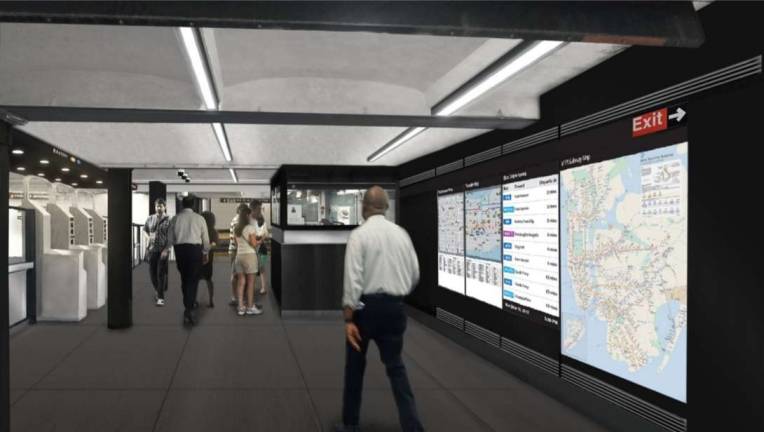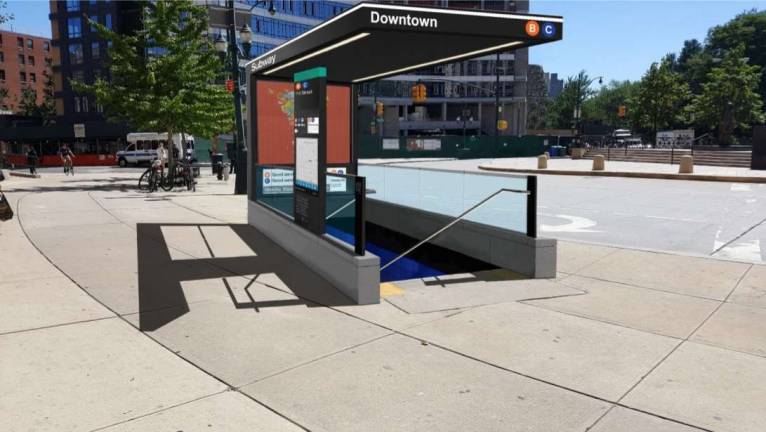MTA service changes to hit UWS


Upper West Side transit riders are preparing for a springtime schedule that will include reduced bus service on a crucial Broadway route and the closure of several subway stations.
In April, the MTA plans to cut service on the M104 bus, which travels from Harlem to Times Square, running along Broadway on the Upper West Side.
The cuts are relatively modest — translating to one fewer scheduled bus per hour in each direction during morning peak, midday and evening service — but the M104 has been targeted for cuts on other occasions in the last decade, including the 2010 elimination of the route's crosstown segment along 42nd Street, which provided riders with a one-seat path from Harlem to the East Side.
The MTA said the service changes are intended “to more closely align service with customer demand and to meet established bus loading guidelines” in its explanation for the cuts. Average weekday ridership on the M104 dropped 35 percent from 2011 to 2016.
The drop in M104 ridership is in line with a broader citywide trend. Average weekday ridership on New York City Transit buses in 2017 was down 5.6 percent over the previous year, marking the fifth successive year in which bus ridership dropped. Average weekday NYCT bus ridership is down over 11 percent since 2012.
Assembly Member Linda Rosenthal sees the MTA's practice of using declining ridership to justify bus cuts results as problematic. “New York City Transits seem to look at charts of numbers and calculate based on some formula that we should have fewer buses,” she said. “They're not taking into account the reasons and the background behind why bus ridership is falling.”
“People who need to get places know they are going to be late if they stand there and wait for the M104,” she continued. “That has contributed to people abandoning the bus, and thus begins the cycle where the buses don't perform properly, people can't rely on the bus to get them where they're going in a timely fashion so they take other modes of transportation, which then makes the MTA say 'fewer people are riding so we're going to lessen the frequency of the bus.' And that cycle never ends.”
City Council Member Helen Rosenthal said she too is “deeply troubled” by the M104 cuts, which she called “short-sighted.”
“If there's less bus service, there's just going to be less ridership,” she said. “Until they can show sustained, reliable service at a normal level, people are going to find other modes of transportation. It's not fair to the residents.”
The cuts are scheduled to take effect in April, the same month in which new NYCT President Andy Byford has said the agency would present an action plan for improving the city's bus system.
Linda Rosenthal said that NYCT should wait until the bus plan is released before implementing service reductions. “One thing I want to be sure of is that they don't cut the M104 further until the report comes out and we have much more of a dialog between riders and former riders and the agency,” she said.
SUBWAY STATION CLOSURESElsewhere on the Upper West Side, a few blocks east from the M104's Broadway stops, subway riders are preparing for the temporary closure of several B and C train stations along Central Park West.
The 72nd Street, 86th Street and 110th Street stations will each close for repairs this spring on a staggered schedule announced by the MTA in February. The 110th Street station will be the first to close on April 9, followed by the 72nd Street station May 7 and the 86th Street station June 4. Work on each station is scheduled to be completed in under six months.
The $111 million project will also include work on the 163rd Street — Amsterdam Avenue station, for which a closure date had not yet been announced.
The project is part of the MTA's Enhanced Station Initiative, a billion-dollar plan, championed by Gov. Andrew Cuomo, to upgrade 33 stations around the city. Included in the scope of the upgrades are structural repairs and renovated entrances, along with a range of [aesthetic] features, including lighted handrails, countdown clocks, Wi-Fi and USB ports. But the Enhanced Station Initiative has come under fire from some transit advocates and elected officials for what it lacks: the addition of elevators to a subway system in which less than a quarter of all stations are equipped with them.
Helen Rosenthal said accessibility upgrades should have been included in the project. “My feeling is, if you're going to close a station that you should use that as an opportunity to put in an elevator,” she said. “There's no excuse for not doing that. And if their excuse is that that costs too much money, then they need to do more to bring down their costs.”
In a Feb. 23 letter to MTA Chairman Joe Lhota, Linda Rosenthal criticized the MTA for not including elevators in the plan, and also for failing to include increased service on the M10 bus, which runs between Harlem and Columbus Circle along Central Park West, as a mitigation measure during the station closures.
Linda Rosenthal said it is her understanding that the MTA is now reevaluating whether to increase M10 bus service during the closure. But even if M10 service is eventually increased during the closure, she sees the failure to anticipate increased demand during the station shutdowns as symptomatic of repeated shortcomings on the part of the MTA in engaging with the public.
“It's mostly common sense,” she said. “You're closing the subway for six months? There will be repercussions, and you have to prognosticate and be proactive in trying to deal with them before they become real problems that set off a round of complaints and more dissatisfaction with the transportation system.”
Surveys load on desktop browsers only. To take the survey on mobile, click here.
Create your own user feedback survey